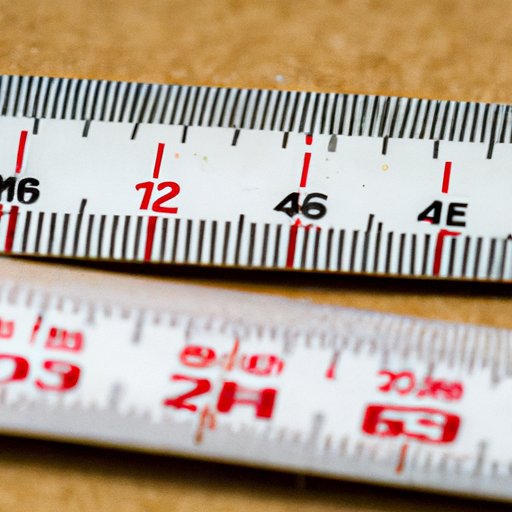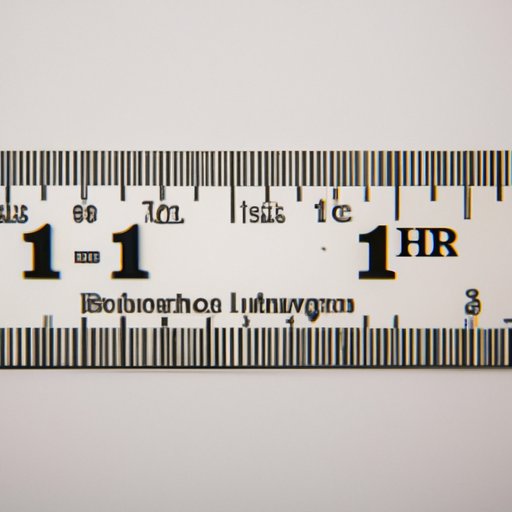
How to Measure Inches and Ensure Accuracy
Measuring inches may seem like a simple task, but it requires the correct tools and techniques to ensure accuracy. Inaccurate measurements can lead to mistakes in various fields, including cooking, sewing, and construction. This article provides an in-depth guide on measuring in inches, using different tools, and estimating techniques, while avoiding common mistakes.

Basics of Measuring Inches
Using a ruler or tape measure is the most common method for measuring in inches. To achieve accurate measurements, it’s critical to use the correct ruler and the right technique. Use a ruler that measures in inches and has clear markings, and make sure it’s fully extended to avoid errors.
Step-by-step guide to measuring in inches using a ruler or tape measure:
- Place the ruler or tape measure at the starting point of the item to be measured.
- Align the edge of the ruler or measure with the item to be measured.
- Record the measurement where the end of the item lines up with the ruler’s markings.
- Always check the reading from the bottom of the marking on the ruler to ensure accuracy.
To avoid common mistakes when measuring inches, ensure that the ruler or tape measure is stable and doesn’t move during the measuring process. Also, measure the item several times and record the average to ensure high accuracy.
Practical Applications of Measuring Inches
Measuring in inches is critical in various applications, including DIY projects, cooking, sewing, and carpentry. In DIY projects and carpentry, measuring in inches helps ensure the correct size of building materials. Accuracy matters when measuring for cooking, especially baking, where a slight deviation can ruin the outcome. Similarly, in sewing, measuring in inches helps ensure correctly sized garments and fabrics.
Measuring in inches is also essential in everyday life. For example, measuring a child’s height can help detect growth and developmental delays.
Measuring Inches in Different Units
Sometimes, it’s necessary to convert measurements from inches to other units depending on the application. Common examples include converting inches to feet, millimeters, or centimeters.
The following steps can be taken to convert inches to different units of measurement:
- For converting inches to feet, divide the total number of inches by 12.
- To convert inches to millimeters, multiply the total inches by 25.4.
- To convert inches to centimeters, multiply the total inches by 2.54
Understanding conversions is particularly crucial when working with foreigners who use different measuring units. Converting inch measurements is also vital when buying foreign products that use a different measuring system.
Common Mistakes When Measuring Inches
Making mistakes while measuring inches is common. One common mistake is not reading the ruler correctly. This can happen when the ruler markings do not align with the object, resulting in wrong measurements. Another mistake is using an old or faulty ruler, resulting in inaccurate readings. When measuring a curved object, the measuring device may not align on the same plane, leading to erroneous readings.
To avoid these mistakes, one needs to use a steady ruler, ensure that the ruler markings align, and measure the object multiple times.
Tools used to Measure Inches
Some tasks require high precision and accuracy that a ruler may not provide. For these tasks, specialized tools such as calipers, micrometers, and laser distance meters can provide a higher degree of accuracy.
Calipers are used to measure the diameter of round objects, such as pipes, nuts, and bolts. They come in both digital and analog versions and can be used for inches and millimeters. Micrometers measure thickness with high precision, especially in machines and technical applications. A laser distance meter is used for complex and technical measurements where the standard ruler is not precise enough.
Estimation Techniques for Measuring Inches
In some situations, measuring devices may not be available, so relatively accurate measurements may be necessary. Estimation techniques can provide close approximations of measurements, and these techniques do not require any specialty tools.
For example, measuring the diameter of a tree can be done by estimating the circumference and dividing by π. Another technique is using common objects such as a dollar bill, which measures 6.14 inches long and 2.61 inches wide, to provide a close representation of measurements.
Conclusion
Accurate measurements of inches are essential in many aspects of life, including cooking, sewing, carpentry, and technical applications. Measuring in inches can also help with precision and accuracy in everyday life. Measuring in inches provides a base of understanding and communication between people who use different measuring systems. By understanding the basics of measuring in inches, using proper tools, avoiding common mistakes, and estimating techniques, one can make accurate measurements with confidence.




